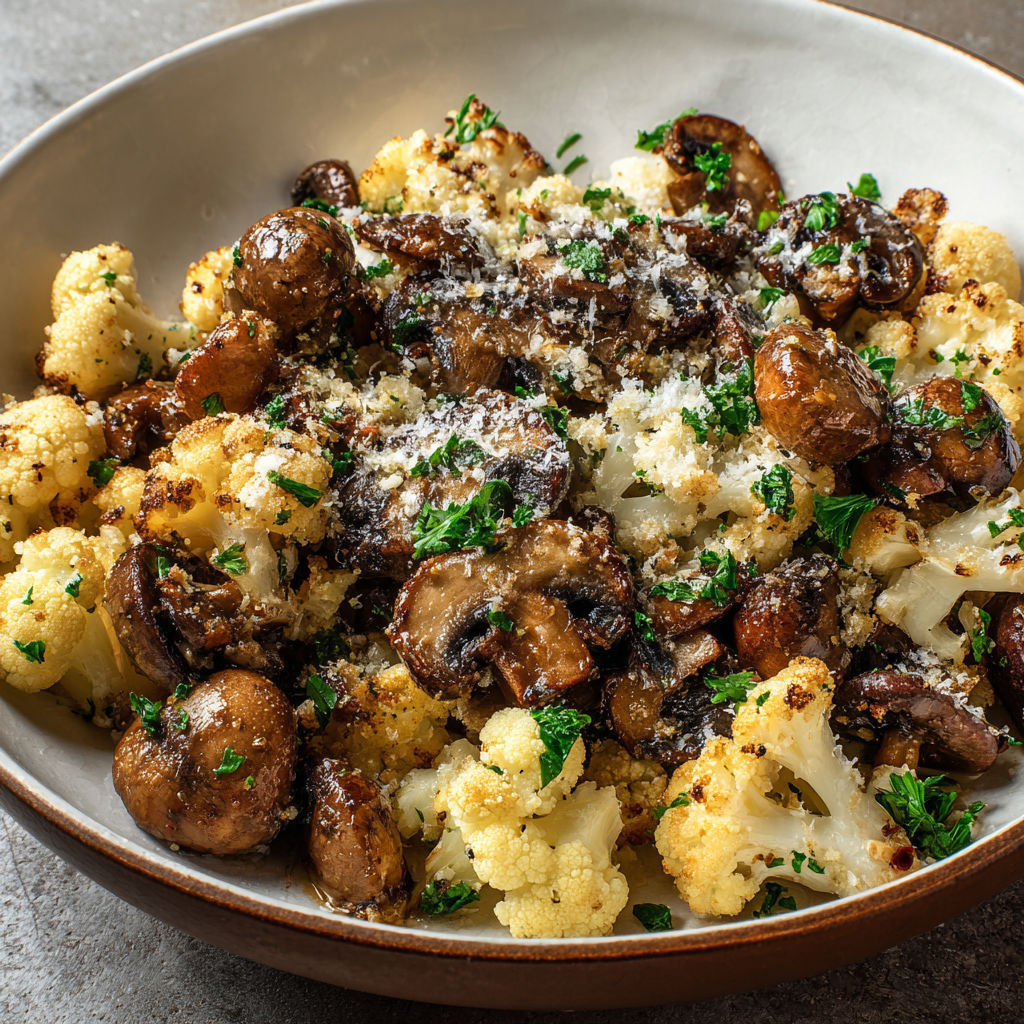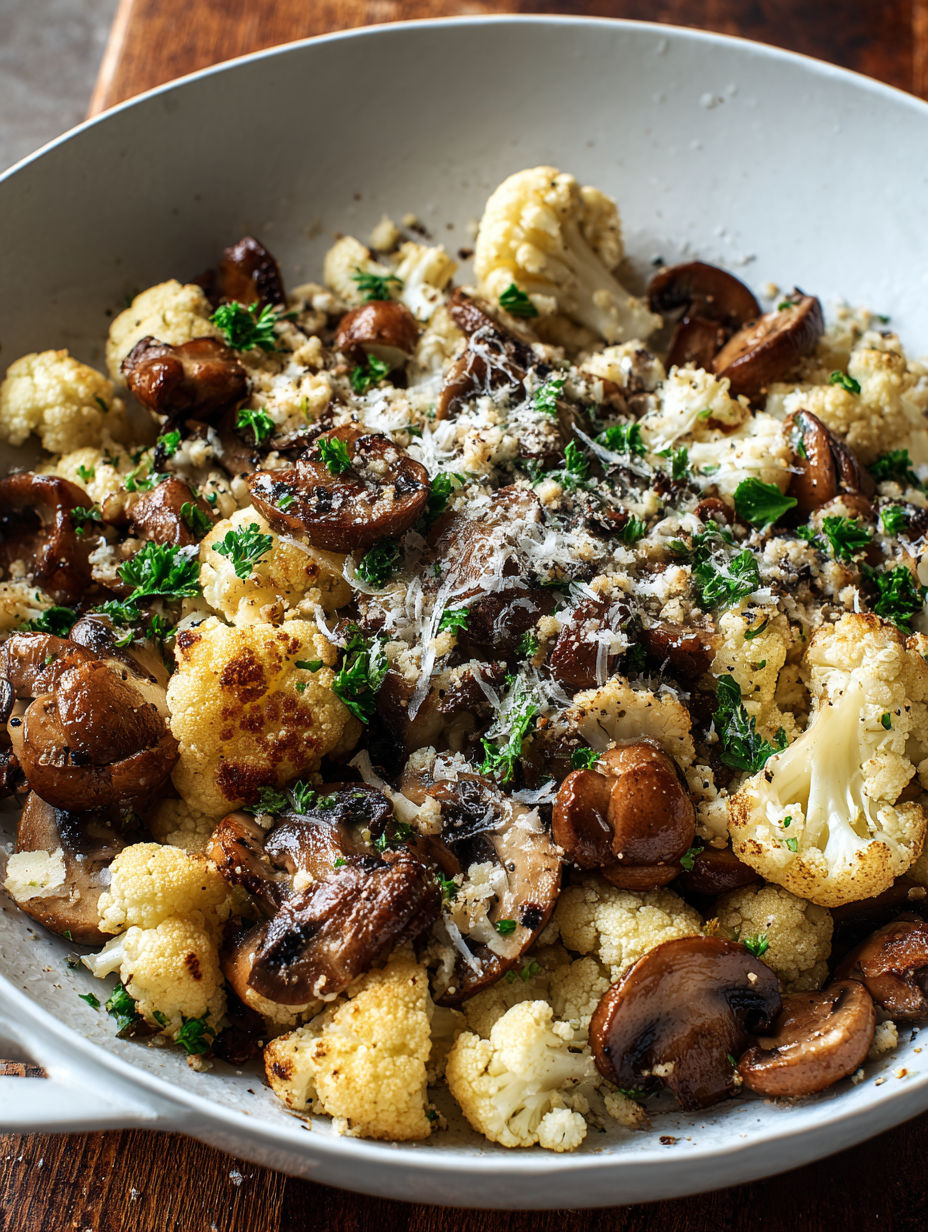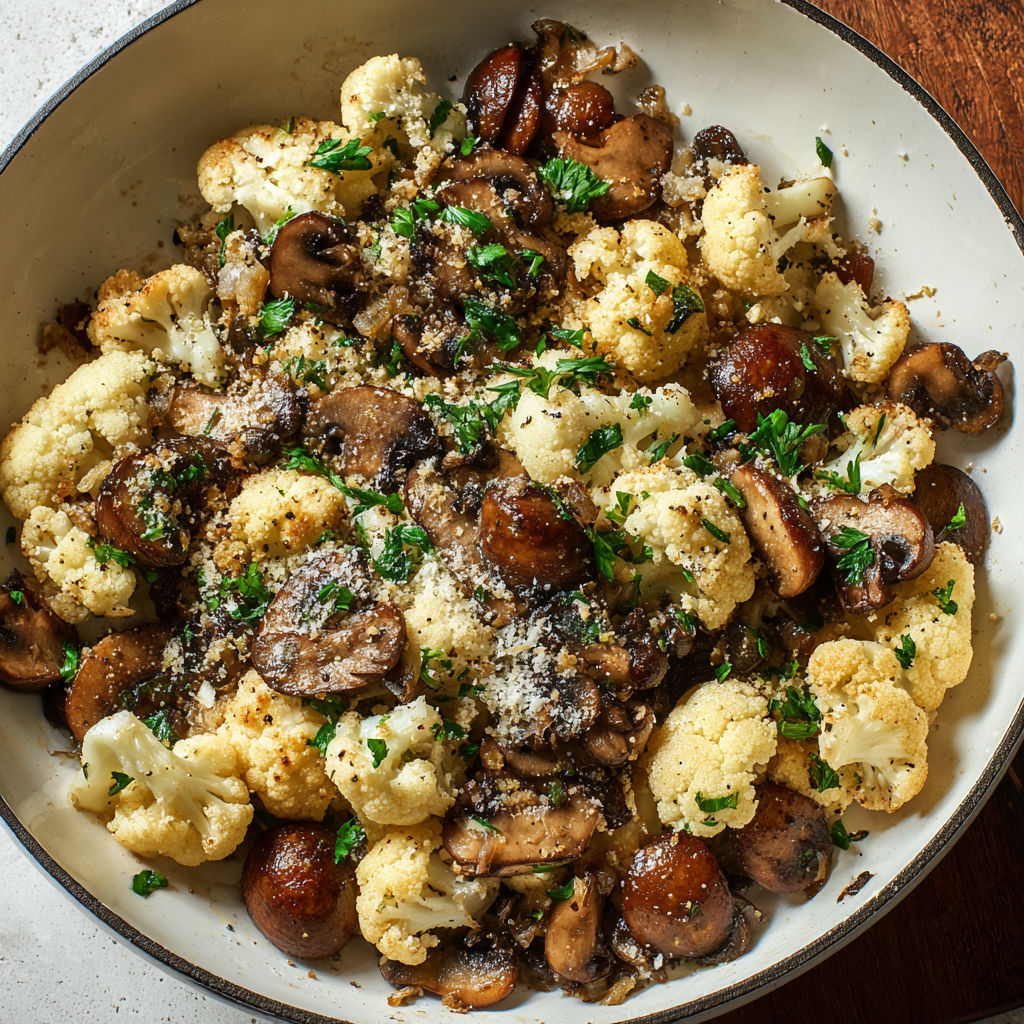 Pin
Pin
This golden-brown duo of sautéed mushrooms and cauliflower crumbles creates a versatile side dish that elevates any meal with its rich umami flavor and satisfying texture. The caramelized edges of both vegetables come together in perfect harmony, making this a dish that disappears quickly at my dinner table.
I first created this recipe when trying to cut back on carbs but still craving something substantial. My husband who typically avoids vegetables ended up stealing bites directly from the pan before I could even serve it. Now it's in our weekly rotation.
- Cauliflower florets: about 300 340g broken into bite sized pieces provides the perfect texture contrast to the mushrooms and absorbs flavors beautifully
- Button or cremini mushrooms: 680g with stems removed delivers deep earthy flavor and meaty texture
- Fresh garlic and shallots: finely minced creates an aromatic foundation that infuses every bite
- Olive oil: divided between vegetables ensures proper caramelization without burning
- Sea salt and black pepper: enhances the natural flavors without overwhelming them
- Stock or white wine: adds depth and deglazes all those flavorful brown bits from the pan
- Fresh parsley: brightens the entire dish and adds a pop of color
- Optional parmesan cheese: provides a salty umami finish that makes everything more luxurious
How To Make Sauteed Mushrooms Cauliflower Crumbles
- Prep Your Ingredients:
- Break cauliflower into small uniform bite sized pieces by hand for even cooking. Remove mushroom stems and halve any especially large ones keeping most whole for better texture. Finely mince garlic and shallots together so they cook at the same rate.
- Crisp The Cauliflower:
- Preheat your skillet thoroughly over medium high heat then reduce to medium. Add just enough olive oil to coat the bottom and add cauliflower with a light seasoning of salt and pepper. Allow cauliflower to develop golden brown edges by resisting the urge to stir constantly. Only toss every minute or two until pieces are crisp tender with caramelized spots about 4 5 minutes. Transfer to a plate to prevent overcooking.
- Perfect The Mushrooms:
- In the same pan add remaining olive oil and mushrooms with light seasoning. The key here is patience. Arrange in a single layer if possible and let them sizzle undisturbed for 4 5 minutes before tossing. Mushrooms release moisture which must evaporate before browning can occur. This takes about 12 15 minutes total. Use a splatter guard to prevent oil splatters as moisture releases.
- Combine And Finish:
- Return crisp cauliflower to the golden mushrooms and add the minced aromatics with a final pinch of salt. The residual heat will cook the garlic and shallot without burning them. A quick deglaze with stock or wine picks up all the flavorful fond from the pan bottom. Finish with fresh parsley stirring just until everything is coated and fragrant.
- Serve With Style:
- Transfer to a serving platter while still hot sprinkle with additional fresh herbs and shower with parmesan if using. The cheese will slightly melt into the warm vegetables creating irresistible pockets of salty goodness.
The real magic of this dish happens when the mushrooms release their moisture and then begin to brown. That transition moment creates concentrated umami flavor that reminds me of the stuffed mushrooms my grandmother would make for special occasions. I remember watching her patiently wait for that precise moment when mushrooms transform from spongy to sublime.
Make Ahead Magic
This dish reheats beautifully which makes it perfect for meal prep. Store cooled leftovers in an airtight container in the refrigerator for up to 4 days. To reheat quickly sauté in a hot skillet with a splash of olive oil until just warmed through. Avoid microwave reheating which can make the vegetables soggy. Fresh parsley added after reheating brings back the vibrant flavor.
Creative Variations
Turn this side dish into a complete meal by adding protein. Grilled chicken sliced steak or even a fried egg transforms these vegetables into a satisfying main course. For vegetarian options toss with cooked quinoa or white beans for additional protein. Flavor variations are endless too try adding fresh thyme rosemary or sage along with the parsley. For a spicy kick incorporate red pepper flakes or a drizzle of chili oil just before serving.
Perfect Pairings
These sautéed vegetables complement almost any protein beautifully. Serve alongside a simply seasoned roast chicken filet mignon or grilled fish. The umami richness makes it particularly wonderful with more delicate proteins like white fish or pork tenderloin where it adds depth without overwhelming. During summer months I serve this at room temperature as part of an antipasto platter with cured meats cheeses and olives for casual entertaining.


Recipe FAQs
- → Can I use different types of mushrooms?
Yes, you can substitute with any mushroom variety like shiitake, oyster, or portobello. Each will bring its unique flavor profile, but cooking times may vary slightly depending on moisture content and size.
- → Is there a way to make this dish vegan?
Absolutely! Simply use vegetable stock instead of chicken stock for deglazing and either omit the parmesan cheese or use a plant-based alternative.
- → How can I store leftovers?
Store cooled leftovers in an airtight container in the refrigerator for up to 3 days. Reheat gently in a skillet over medium heat to maintain texture, adding a small splash of olive oil if needed.
- → What can I serve this with?
This versatile side pairs wonderfully with grilled or roasted meats, fish, or as part of a vegetarian meal with grains like quinoa or farro. It also makes a delicious topping for crostini or mixed into pasta.
- → Can I prepare components ahead of time?
Yes, you can prep all ingredients (chop cauliflower, prepare mushrooms, mince aromatics) up to a day in advance and store separately in the refrigerator. This makes final cooking much quicker when you're ready to serve.
- → Why remove mushroom stems?
Removing mushroom stems creates a more uniform cooking surface and texture. However, you can save the stems for making stock or chop them finely to include in the dish if you prefer not to waste them.
